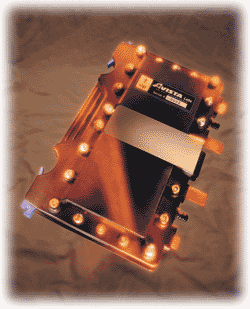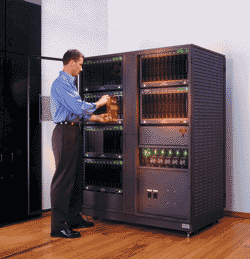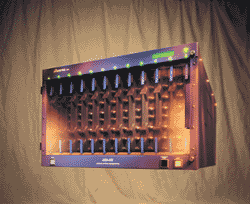Point-Of-Use:
If you are in the market to purchase a fuel cell system, what should you be looking for? What types of questions should you ask? More importantly, what should you watch out for? Fuel cell technology isn’t new, but barring any previous experience in the U.S. Space Program, most early adopters of fuel cell systems will need to learn a few more things about system operating parameters and the trade-offs associated with them. This article is not intended to be an abridged buyer’s guide for the fuel cell customer, but I will address a few issues that should be on the criteria list.
Is bigger power always better? The idea of big power is certainly cool. But is the “more power” philosophy, a la Tim Allen, always appropriate? Even as Mr. Tool-Time frequently discovered, bigger power does not always provide the best solution for an application.
Let’s consider this issue with distributed power operating in a backup mode. There seems to be a popular mindset that backup power should provide the same capacity that was utilized from the electric grid before it went black. The primary purpose of distributed power is to improve overall quality and reliability. But a large backup power system at the edge of your facility still leaves you susceptible to a potential single point of failure and thus a true power outage. Think about it – your business operations are still supported by one system that can, and at some point will, break.
What if we put multiple, smaller backup power systems even closer to the point-of-use and applied greater selectivity for the applications they power – perhaps only those most critical for the business to continue operations? Examples of these applications would include servers, cash registers, personal computers, lighting and select manufacturing processes. This would certainly reduce your outage vulnerability. While this might sound like overkill, we see this approach used in other applications. Look at our server farms. We don’t deploy one giant server to handle all of our communications needs. We use multiple servers so that, in the event of a failure, we can reroute priority traffic to those units still functioning. This concept may sound like an expensive proposition, but remember, you don’t need to power everything during a limited duration grid outage.
Smaller fuel cell units will inherently cost less, on a total system basis, than larger ones and also consume less fuel during their operation. Further, there is a tendency to measure distributed power on a dollar-per-kilowatt basis as an attempt to compare it to the commodity electrons delivered by the local utility. This methodology is futile, since at the time of need for backup power, there is no grid service and there are no commodity electrons. What we are actually trying to do is avoid the potentially catastrophic cost of not having power. According to Allied Business Intelligence, the costs of power outages to e-commerce companies can range as high as $1 million per hour to $1 million per minute of outage.
Small-scale fuel cells also provide greater flexibility – you can incrementally increase your backup power capacity as your critical needs (power requirements) grow, without incurring a sunk cost with the existing generation system.
Keep in mind that the closer you put the power supply to the actual point-of-use, the greater reliability and quality will be realized.
This is, after all, what most customers are looking for. And the demand for digital quality power is expected to grow significantly throughout the decade.
Efficiency Games:
System efficiency is an important operating characteristic when evaluating distributed power units. Fuel cells can boast of efficiency levels well beyond those of reciprocating generator sets, but these statistics can also be misleading. Fuel cell efficiency curves run opposite to those of gen sets. Gen sets are most efficient at or near full load. Fuel cell efficiencies actually increase as the percentage of load to system capacity decreases. Therefore, a larger capacity fuel cell handling a small load application can project very attractive efficiency levels. And efficiency numbers can be a very effective marketing tool.
But haven’t we really just over-engineered a solution for you, the customer, by selling more capacity – at a higher up front capital cost – than is actually needed? This scenario reminds me of the octane wars that big oil launched in the 80’s. The ads for higher-octane levels made for impressive statistics, but they were really selling most customers more octane than they needed.
The main reason efficiency levels are important to us is because we associate these directly with fuel consumption and thereby, operating expense. However, provided that the full load efficiency levels of two competing fuel cell systems are similar, the primary determinant of fuel consumption is ultimately the size of the load itself relative to the capacity of the fuel cell system.
Let’s look at a hypothetical case. A customer is comparing two competing fuel cell systems to address the requirements of a 3kW load. Developer A offers a modular fuel cell system that can provide a 3kW capacity to meet the customer’s needs. Developer B offers a standard design fuel cell system with a 5kW capacity. Both systems have an efficiency level of about 37% at full load, and both can handle the load requirement for the customer. The 5 kW standard design fuel cell, however, can claim an even higher efficiency level at this application because the load is a smaller percentage of the overall system capacity. That higher efficiency will initially sound like an attractive proposition to the customer, but in the end, economics rule. The real question the customer will have to address is if the additional cost of a higher capacity system is worth the higher efficiency level being offered. In other words, what’s the payback?
Let’s assume that Developer A is offering the modular 3kW fuel cell system at $5,000 per kW, and Developer B is offering the standard design 5kW fuel cell system at a more competitive $4,500 per kW. And, because this standard design fuel cell has much more capacity than the load itself, we’ll raise the estimated efficiency level of system B to 42%. At an average commercial natural gas fuel price of $9.00 per thousand cubic feet, and assuming each system runs for a full year, the economic comparison of the two systems in this application is outlined in the table below.
So, what’s the payback?
If the customer asks the right questions and does the math, he will discover that it will take nearly 29 years for the actual savings from reduced fuel consumption to offset the additional installed cost of the “higher efficiency” system. Even in today’s economic environment, we can all find better places to invest the $7,500 that might have been spent on the higher capacity system. Still, developers of standard, less modular designs will make a good pitch for higher capacity, higher efficiency systems because they don’t have the flexibility to meet specific load requirements. They can’t build to order.
If the customer is concerned about growing power requirements in the future, perhaps the system that is most easily scalable will also be attractive. The time-value of money concept best serves the customer – pay as you need it, instead of paying all up front for unusable capacity.
Consider Life Cycle Costs:
Perhaps the customer’s concern about operating expenses should be focused on overall reliability and system maintenance requirements. Fuel cells will, at least for the next few years, require a significant up front capital cost. Obviously, the payback on this investment can be improved with a fuel cell system that has fewer things that can break – less balance of plant. Also, a fuel cell system that offers greater reliability will require less emergency maintenance or less redundancy of additional backup equipment. Any system with “hot-swappable” components offers a significant advantage in addressing these issues because it can be easily repaired while the unit remains on-line. A fuel cell system with “hot-swappable” components will greatly reduce downtime and repair costs.
The installed cost of fuel cell systems will always be among a customer’s selection criteria. However, the cost of operation is not included in this figure, and as customers become more knowledgeable about this technology, they will begin to examine the total life cycle costs of fuel cell ownership. Criteria such as system reliability (versus the cost of a power outage), annual maintenance expenses, fuel consumption and lifetime expectancy will continue to grow in importance in the customer’s decision-making process.
Finally, let’s not underestimate the importance of simplicity or ease-of-use. New technology that is relatively unfamiliar to customers will have an inherent advantage if it is easy to operate and user-friendly. After all, this stuff isn’t rocket-science…anymore.
If you are in the market to purchase a fuel cell system, what should you be looking for? What types of questions should you ask? More importantly, what should you watch out for? Fuel cell technology isn’t new, but barring any previous experience in the U.S. Space Program, most early adopters of fuel cell systems will need to learn a few more things about system operating parameters and the trade-offs associated with them. This article is not intended to be an abridged buyer’s guide for the fuel cell customer, but I will address a few issues that should be on the criteria list.

Is bigger power always better? The idea of big power is certainly cool. But is the “more power” philosophy, a la Tim Allen, always appropriate? Even as Mr. Tool-Time frequently discovered, bigger power does not always provide the best solution for an application.
Let’s consider this issue with distributed power operating in a backup mode. There seems to be a popular mindset that backup power should provide the same capacity that was utilized from the electric grid before it went black. The primary purpose of distributed power is to improve overall quality and reliability. But a large backup power system at the edge of your facility still leaves you susceptible to a potential single point of failure and thus a true power outage. Think about it – your business operations are still supported by one system that can, and at some point will, break.
What if we put multiple, smaller backup power systems even closer to the point-of-use and applied greater selectivity for the applications they power – perhaps only those most critical for the business to continue operations? Examples of these applications would include servers, cash registers, personal computers, lighting and select manufacturing processes. This would certainly reduce your outage vulnerability. While this might sound like overkill, we see this approach used in other applications. Look at our server farms. We don’t deploy one giant server to handle all of our communications needs. We use multiple servers so that, in the event of a failure, we can reroute priority traffic to those units still functioning. This concept may sound like an expensive proposition, but remember, you don’t need to power everything during a limited duration grid outage.
Smaller fuel cell units will inherently cost less, on a total system basis, than larger ones and also consume less fuel during their operation. Further, there is a tendency to measure distributed power on a dollar-per-kilowatt basis as an attempt to compare it to the commodity electrons delivered by the local utility. This methodology is futile, since at the time of need for backup power, there is no grid service and there are no commodity electrons. What we are actually trying to do is avoid the potentially catastrophic cost of not having power. According to Allied Business Intelligence, the costs of power outages to e-commerce companies can range as high as $1 million per hour to $1 million per minute of outage.

Small-scale fuel cells also provide greater flexibility – you can incrementally increase your backup power capacity as your critical needs (power requirements) grow, without incurring a sunk cost with the existing generation system.
Keep in mind that the closer you put the power supply to the actual point-of-use, the greater reliability and quality will be realized.
This is, after all, what most customers are looking for. And the demand for digital quality power is expected to grow significantly throughout the decade.
Efficiency Games:
System efficiency is an important operating characteristic when evaluating distributed power units. Fuel cells can boast of efficiency levels well beyond those of reciprocating generator sets, but these statistics can also be misleading. Fuel cell efficiency curves run opposite to those of gen sets. Gen sets are most efficient at or near full load. Fuel cell efficiencies actually increase as the percentage of load to system capacity decreases. Therefore, a larger capacity fuel cell handling a small load application can project very attractive efficiency levels. And efficiency numbers can be a very effective marketing tool.
But haven’t we really just over-engineered a solution for you, the customer, by selling more capacity – at a higher up front capital cost – than is actually needed? This scenario reminds me of the octane wars that big oil launched in the 80’s. The ads for higher-octane levels made for impressive statistics, but they were really selling most customers more octane than they needed.
The main reason efficiency levels are important to us is because we associate these directly with fuel consumption and thereby, operating expense. However, provided that the full load efficiency levels of two competing fuel cell systems are similar, the primary determinant of fuel consumption is ultimately the size of the load itself relative to the capacity of the fuel cell system.
Let’s look at a hypothetical case. A customer is comparing two competing fuel cell systems to address the requirements of a 3kW load. Developer A offers a modular fuel cell system that can provide a 3kW capacity to meet the customer’s needs. Developer B offers a standard design fuel cell system with a 5kW capacity. Both systems have an efficiency level of about 37% at full load, and both can handle the load requirement for the customer. The 5 kW standard design fuel cell, however, can claim an even higher efficiency level at this application because the load is a smaller percentage of the overall system capacity. That higher efficiency will initially sound like an attractive proposition to the customer, but in the end, economics rule. The real question the customer will have to address is if the additional cost of a higher capacity system is worth the higher efficiency level being offered. In other words, what’s the payback?
Let’s assume that Developer A is offering the modular 3kW fuel cell system at $5,000 per kW, and Developer B is offering the standard design 5kW fuel cell system at a more competitive $4,500 per kW. And, because this standard design fuel cell has much more capacity than the load itself, we’ll raise the estimated efficiency level of system B to 42%. At an average commercial natural gas fuel price of $9.00 per thousand cubic feet, and assuming each system runs for a full year, the economic comparison of the two systems in this application is outlined in the table below.
| Modular System | Standard System | |
| Capacity | 3kW | 5kW |
| Load (100% load factor) | 3kW | 3kW |
| Efficiency@Load | 37% | 42% |
| System Cost | $15,000 | $22,500 |
| Fuel Cost/1000 cu ft. | $9.00 | $9.00 |
| Annual Fuel Usage | 242,330 cu ft. | 213,482 cu ft. |
| Annual Fuel Cost | $2,180.97 | $1,921.33 |

So, what’s the payback?
If the customer asks the right questions and does the math, he will discover that it will take nearly 29 years for the actual savings from reduced fuel consumption to offset the additional installed cost of the “higher efficiency” system. Even in today’s economic environment, we can all find better places to invest the $7,500 that might have been spent on the higher capacity system. Still, developers of standard, less modular designs will make a good pitch for higher capacity, higher efficiency systems because they don’t have the flexibility to meet specific load requirements. They can’t build to order.
If the customer is concerned about growing power requirements in the future, perhaps the system that is most easily scalable will also be attractive. The time-value of money concept best serves the customer – pay as you need it, instead of paying all up front for unusable capacity.
Consider Life Cycle Costs:
Perhaps the customer’s concern about operating expenses should be focused on overall reliability and system maintenance requirements. Fuel cells will, at least for the next few years, require a significant up front capital cost. Obviously, the payback on this investment can be improved with a fuel cell system that has fewer things that can break – less balance of plant. Also, a fuel cell system that offers greater reliability will require less emergency maintenance or less redundancy of additional backup equipment. Any system with “hot-swappable” components offers a significant advantage in addressing these issues because it can be easily repaired while the unit remains on-line. A fuel cell system with “hot-swappable” components will greatly reduce downtime and repair costs.
The installed cost of fuel cell systems will always be among a customer’s selection criteria. However, the cost of operation is not included in this figure, and as customers become more knowledgeable about this technology, they will begin to examine the total life cycle costs of fuel cell ownership. Criteria such as system reliability (versus the cost of a power outage), annual maintenance expenses, fuel consumption and lifetime expectancy will continue to grow in importance in the customer’s decision-making process.
Finally, let’s not underestimate the importance of simplicity or ease-of-use. New technology that is relatively unfamiliar to customers will have an inherent advantage if it is easy to operate and user-friendly. After all, this stuff isn’t rocket-science…anymore.







